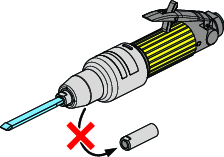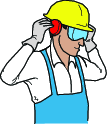Before Starting to Work
Tool check

Always use a retainer.
Inspect the retainer for wear and damage regularly.
The tool and its accessories must not be modified in any way.
The trigger must never be removed or fixed by tape for example.
If the trigger is not working properly, make sure that it is replaced.
The air supply coupling should be separated from the tool by a whip hose.
Personal protection equipment

Make sure the operators use:
Eye protection, goggles or a visor.
Ear protection.
Gloves.
Steel toe-capped shoes.
Protective clothing, such as a leather apron.
A helmet (for heavier applications).
Do not use loosely hanging clothing, hair or jewellery (risk of getting caught).
Working Area

Ensure that the area in which you are working is kept free from other people so that no one can get injured.
People nearby must also wear hearing and eye protection.
Check that there is good ventilation and dust extraction from the premises.
There should be a stand or a place available, on which the machine can be safely placed.
Work within a sealed-off area, if possible with protecting walls.
Explosive atmosphere must not be ignited - use accessories of non-sparking material.
Avoid chiseling into electric wiring hidden inside walls.










































